Unit Theme: The American Scene
Author: Lucy Andrus
The theme of this unit for our teens in special education and our fifth graders in an inclusion class focused on exploration of the art and cultural traditions of people of the Americas, leading up to the formation of the United States of America. We began by learning about the Native people indigenous to the eastern woodlands area of North America: the Haudenosaunee (also known as the Iroquois). Traveling west, we studied Mexican culture and created our own observance of the tradition of Dia de los Muertos (Day of the Dead) which the students shared with their entire school. Coming back east led us into an exploration of the first European settlers whose descendants were to form a new nation.
1. When Two World’s Unite: A New View
2. Family Emblems, Inspired by the Haudenosaunee
3. Birds in the Wild, Inspired by The Art of John Audubon
4. What Do You Bring to theTable? Plates of Contribution
5. Spirit Sticks of Thanksgiving
School 68
Lesson 1: When Two World’s Unite: A New View
Conceptual Basis of the Lesson
This focus of this lesson in our unit was on the migration of Europeans to North America, and what happened when two very different cultures (Europeans and North American Native people) were introduced to one another. We began by learning reasons why Europeans came to America, what they brought with them, and the challenges they were faced with when they got here. The students compared and contrasted differences in lifestyles, including food, clothing, shelter and means of transportation, as well as cultural differences in European and Native beliefs about land and ownership, developing an understanding of how European and Native ways and means of living clashed. The students also explored ways in which Europeans and Native people did come together, what they shared, and what they learned from each other. After viewing the Edward Hicks’ painting, Peaceable Kingdom, students were then be asked to reconsider how these two cultures could have united in a more positive and productive manner, sharing and integrating ideas and beliefs for the greater good of all.
The students worked cooperatively in small groups to express these ideas of merging the best of both worlds through the creation of a diorama that re-envisions history.


Relation to Life
In order to secure a positive future, it is important for students to study the past to understand and appreciate the diversity that underlies this nation. Our essential humanity is what puts us all on common ground with each other. Students must realize the importance of sharing and communicating ideas between different groups of people, including themselves, and that our survival as a planet and species depends on mutual interdependence and support for unity through awareness and respect for diversity.
McKinley H.S.
Lesson 2: Family Emblems, Inspired by the Haudenosaunee
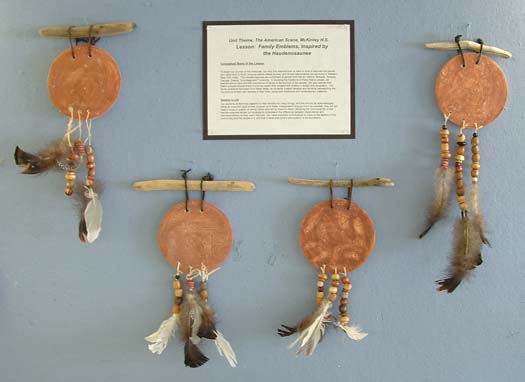
Conceptual Basis of the Lesson
To begin our journey of the Americas, our very first lessons took us back in time to discover the people who were here in North America before others arrived, and whose descendents are still living in Western New York today. The Haudenosaunee are comprised of people from the six nations: Mohawk, Seneca, Cayuga, Oneida, Onondaga and Tuscarora. In studying the traditions of these Native people, we learned about clans and the importance of family to the survival of the people. We also learned that Native people imbued every functional object they created with artistry in design and decoration. Our family emblems borrowed from these ideas, as students created designs and symbols representing the importance of their own families in their lives, using both traditional and contemporary materials.
Relation to Life
Our students at McKinley depend on their families for many things, and this should be acknowledged. While an important goal of their program is to foster independent living as much as possible, they will still need a support system of caring others who will be there for them. Studying the communal life of the Haudenosaunee allows our students to understand the difference between dependence and interdependence as they learn that they, too, have important contributions to make to the welfare of the community and the people in it, and that it takes everyone’s participation to be successful.
McKinley H.S.
Lesson 3: Birds in the Wild, Inspired by
The Art of John Audubon
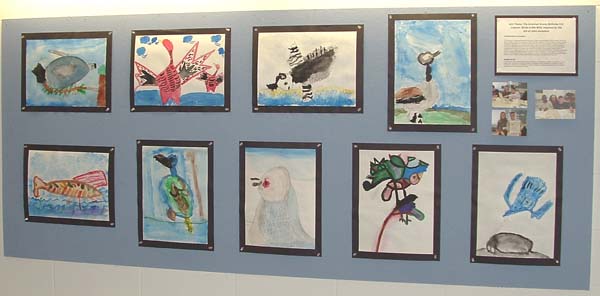
Conceptual Basis of the Lesson
For this lesson, the students learned of the work of artist and ornithologist, John Audubon, whose life work included a visual documentation of North American wildlife in the early 1800’s. Audubon traveled through the backwoods of the USA, drawing birds in the wild, which were later made into mostly life-sized color engravings and published over eleven years in the famous Birds of America volumes. Audubon’s important contribution to the knowledge and appreciation of the birds of America proved inspirational to the effort to preserve our natural environments. After studying reproductions of Audubon’s bird images, actual bird nests, and three-dimensional artificial birds, the students exercised their own drawing and painting skills in creating portraits in watercolor. Once again challenged by a medium and process with which they had little or no prior experience, the students were able to apply their growing artmaker competencies to produce paintings that delight as well as inform.
Relation to Life
In this lesson, the students learned of the importance of documenting, preserving and caring for our wildlife and natural environments. Empathy for the earth and its inhabitants is cultivated, helping students to extend their contributions to society by learning to share responsibility for the collective stewardship of our natural environments.
McKinley H.S.
Lesson 4: What Do You Bring to theTable? Plates of Contribution
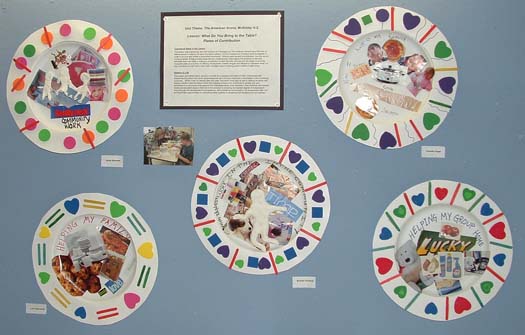
Conceptual Basis of the Lesson
This lesson was inspired by the USA tradition of Thanksgiving. The students learned about the role of Native people in helping the early European settlers, and the importance of people working together in order to survive and create a productive community. Without each person’s contribution, survival would not be possible. Bringing these ideas into our contemporary lives helped the students to see and articulate their own roles in making a contribution to their families, schools and the larger community. Using the plate as a symbol of offering, the students created images and designs to represent what it is they contribute to their community, from volunteer work to helping perform tasks of daily living.
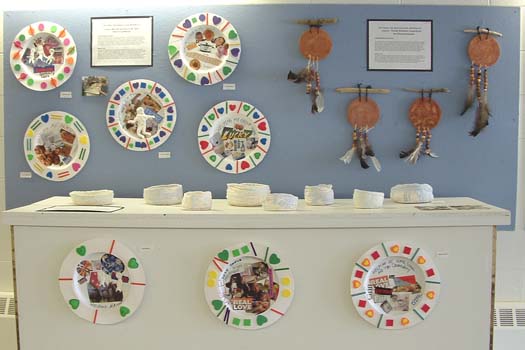
Relation to Life
This lesson and others like it, serve to promote the purposes and intent of IDEA (Individuals with Disabilities Education Act) which emphasizes the right of every individual to participate in and contribute to society. While it has not always been the case, education must play its part in helping students with special needs to become active rather than passive citizens who contribute to society and who participate in a community that supports the interdependence of its members. How students with special needs are educated plays a vital role in this process by ensuring the highest degree of independent living through the development of competence, self-confidence and empathy. Art experiences offer rich and significant opportunities for cultivating these qualities in students of all backgrounds and abilities.
School 68 Third Grade Inclusion Class
Lesson 5: Spirit Sticks of Thanksgiving
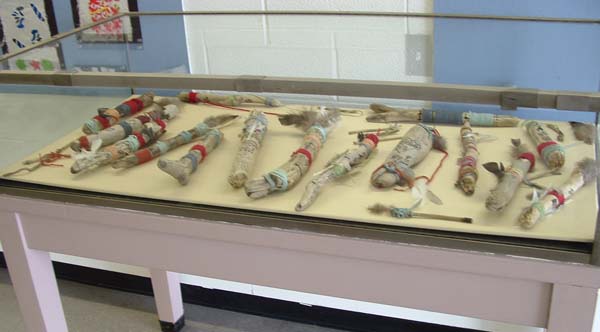
Conceptual Basis of the Lesson
Following an introductory lesson on Haudenosaunee culture which included discussion and viewing of slides artifacts, we focused on the spiritual beliefs and traditions of these Eastern Woodlands people, with an emphasis on giving thanks for what is provided by The Great Creator in order to sustain the people. The students explored the shared traditions of the Haudenosaunee society, and how each generation of the people sees itself as a carrier of culture for the sake of future generations. We learned how the ethics, mores, and philosophy of the Haudenosaunee are at the core of their identity, and we discovered how their beliefs are reflected in the use of the arts to express their spirituality visually, musically, and in ritual. The students were asked to examine their own ideas about thanks-giving for the things that sustain them in their lives, and then use visual symbols to convey these meanings.
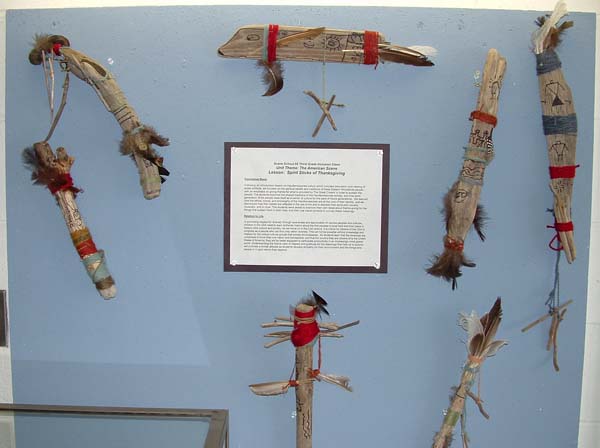
Relation to Life
In promoting respect for diversity through awareness and appreciation of various peoples and cultures, children in the USA need to learn authentic history about the first peoples to exist here and their place in today's USA culture and society. As we move on in the 21st century, it is critical for citizens of the USA to progress as a people who can find unity within diversity. This will not be possible without knowledge and respect for the unique cultural groups that society encompasses. As students learn that the Americas are comprised of more than one nation and hemisphere, and that the country they are citizens of is the United States of America, they will be better equipped to participate productively in an increasingly more global
world. Understanding the Native view of respect and gratitude for the blessings that help us to survive will cultivate a similar attitude as students develop empathy for their environment and the things and people in it upon whom they depend.
School 68
Lesson 6: Colonial Women’s Handwork as Artistic Expression

Conceptual Basis of the Lesson
In this lesson of our unit, we explored the role of women in Colonial America prior to the revolution, with a focus on recognition of women’s handwork not only for its vital domestic function but also as a form of artistic and aesthetic expression. Students learned about various roles within the family aimed at contributing toward its welfare, particularly how women maintained and cared for their families. This included an incredible output of handwork to create items of necessity -clothing, linens, floor coverings, blankets, rugs, floor mats, - as well as decorative items and other domestic objects involving such processes as quilting, spinning, weaving, knitting and stenciling. With the emphasis on survival, women’s work had to have practical purpose and contribute to the daily living needs of the family, but the students also learned how such functional handwork also provided opportunities for the artistic expression and development of colonial women, who would have had little or no opportunity to pursue formal study as artists. In creating their own samplers using techniques of stenciling and stitching, the students experienced first-hand some of the processes used by colonial women to bring beauty and artistry into lives dominated by the harsh realities of survival.
Relation to Life
This lesson fosters understanding and appreciation for women’s contributions to the birth and survival of a nation as well as their often overlooked contributions to the arts. Learning about the struggles of the early settlers helps students to respect the hard work and determination needed by everyone for survival of the community, a far different experience than today’s emphasis on comfort and consumption.
Spring 1998 BUILD Academy, Second Grade Inclusion Class
Lesson 7: Freedom Quilt of Safe House Signs
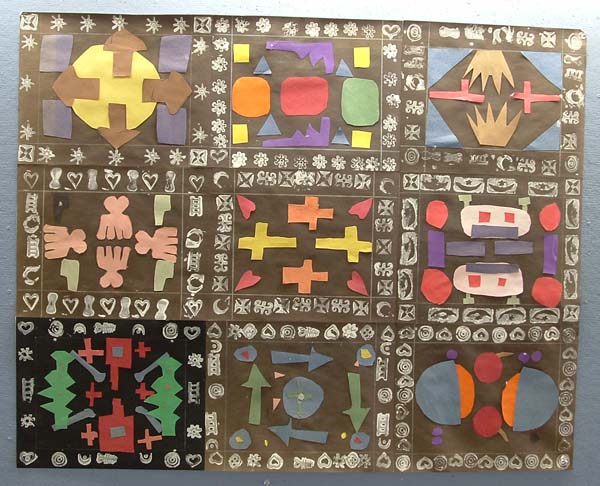
Conceptual Basis of the Lesson
As part of our journey through North America, we learned about the lives and work of important Americans, including the two African-American women who inspired this artwork: social activist and abolitionist, Harriet Tubman and contemporary artist and children’s book author, Faith Ringgold. The children were somewhat familiar with Harriet Tubman and the Underground Railroad. What they didn't know much about was how visual symbols and the artistic designs in quilts (which were displayed on the roof or porch railing of a safe house) were used as a means of non-verbal communication to help guide enslaved people who were escaping to the north. Faith Ringgold's wonderful book, Aunt Harriet's Underground Railroad in the Sky, provided the backdrop for our project as we followed the adventures of Cassie and her brother Bebe making their way to freedom with the help of Aunt Harriet and the underground railroad conductors.
In our discussion, we wondered what it might be like to be forced into slavery and then attempt to escape. We then wondered what it would be like to operate a safe house and be a conductor on the railroad. The children were asked to ponder two questions: If you were a person escaping, what kinds of things would you need? And if you were a conductor, what kinds of things could your safe house offer this person? In response to the latter, the children listed many important things, including the offering of a safe place to pray without fear. These ideas became the basis for creating our safe house signs. The challenge faced by the children was to create a quilt piece that could somehow tell a weary traveler what their safe house had to offer using only visual symbols, and without giving the message away to a slave catcher. The children called upon their knowledge of art elements and principles to create their symbolic messages and maintain their secrecy. The use of African Adinkra symbols also helped to disguise messages and prevent enemies from deciphering them. Can you tell what each safe house has to offer by "reading" our quilt pieces?
This is a non-commercial website and is to be used for educational or research purposes only. No commercial use is permitted without the consent of Art Partners. "Fair use" is claimed under U.S. copyright law, sections 107 and 108. For questions contact:Art Partners
©2002 Art Partners Program | All Rights Reserved